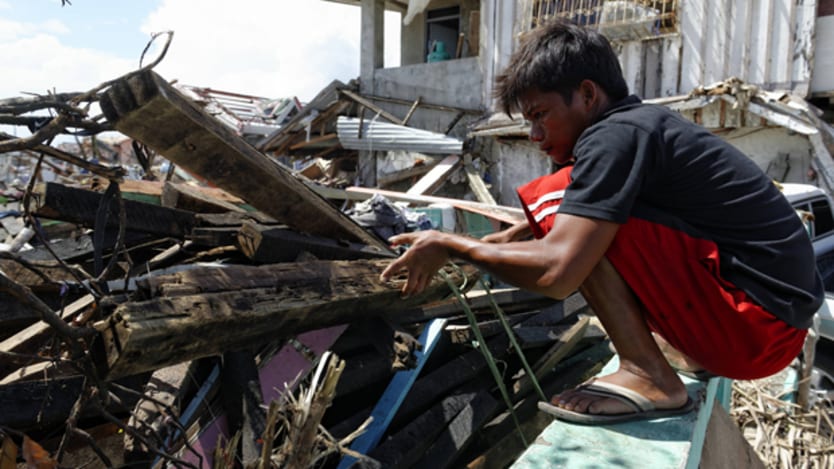
Full-scale recovery and rehabilitation in areas affected by Typhoon Haiyan in the Philippines have been a huge challenge for both the government and the international development community — and the quandary may continue as the issue of land security heats up with victims still struggling to find permanent settlement.
It’s been nine months since Haiyan wreaked havoc throughout the country’s central Visayas region, killing over 6,000 people and destroying billions in property. While significant progress has been made in terms of immediate relief and recovery, and parts of the “ground zero” city of Tacloban already back to normal, long-term rehabilitation including sustainable housing and livelihood remains to be seen.
To address this complex challenge, Oxfam International suggested in a report that local policies involving land reform and security of tenure should be bridged, polished and updated to fast-track resettlement programs for Haiyan victims to get them back on their feet instead of pushing them further to poverty.
“Land and the lack of appropriate land titles and others exacerbates the inequality that does exist as well as it is seen that people cannot make the right choices to make themselves resilient to natural disasters,” Justin Morgan, Oxfam country director in the Philippines, told Devex. “The combination of both these things is [central] to what poverty is here.”
He added that insecurity of land tenure has always been a persistent problem in the country, where the numbers of informal settlers and those without formal land ownership continue to rise. The catastrophe only amplified the issue.
“What we’ve seen is that there are significant issues around land policy and land reform prior to Haiyan so to say that Haiyan brought the issues to them would not be fair. It is exacerbated by natural disasters when people are needed to relocate or forced to relocate … and certain individuals like those from Haiyan may be subject to more vulnerability,” Morgan explained.
Since the typhoon struck in November 2013, about five million people has been displaced in the Visayas region and a significant number are still without permanent homes despite the government’s much-trumpeted plans to provide temporary bunkhouses, criticized for their alleged failure to adhere to international standards.
In a field visit conducted by Devex in June, several families in Tacloban had built their homes and communities where their old houses stood despite the government’s advisory that some of these areas had been tagged as “no-build zones” due to their vulnerability to disasters. Some of the families shared that the lack of a concrete resettlement plan contributes to their decision to stay put.
Conundrum
National statistics show that around a third of the total population in the hardest-hit regions of Leyte and Samar are informal settlers — precipitating the idea of the lack of formal land security.
Oxfam said that “tenure insecurity creates cycles of vulnerability to natural disasters” which can lead into further poverty — as evictions prevent restoration of livelihoods — and relocation to unsafe lands. Calamities like Haiyan, the report argues, “provide opportunities for land speculation and land grabs as a result of population displacement and massive relocation programs.”
Despite the government’s efforts, there’s still a discrepancy between the government’s stated goals and the actual requirements for subsidized resettlement.
See more news on Haiyan recovery:
● The wrong time to pull back
● Post-Haiyan efforts: On the right track, but a long way to go
● On the ground after Haiyan, money is not always the challenge
● Philippines rebuilds 6 months after Haiyan as typhoon season looms
● Six months later, (still) mixed feelings on post-Haiyan recovery
“We have seen in some study [that] there are some that have formal titles of their land and those people are generally the better off ones and the choices are a lot clearer,” Morgan said. “[But] many of the victims don’t have the titles and the choices of where they’re going to resettle are difficult.”
Some of the criteria for relocation set by local government units in the affected areas, according to Oxfam, exclude people who lived in boarding houses and/or apartments, informal settlers who have been living outside the no-build zone, and those who refuse to take “emergency accommodation assistance.”
The program instead requires beneficiaries to submit proof of at least 10 years of land tenure, which of course informal settlers lack. Morgan argued that this defeats the purpose of providing full and sustainable recovery to victims, and the report notes that move has the “perverse effect of excluding large numbers of people simply because of their insecure tenure status.”
So how can the government and the international development community address this?
Oxfam suggests that concerned departments and agencies streamline, update and implement relevant policies as well as put point people to focus on the issue itself to speed up the process, avoid inefficiency and inconsistency and ensure that affected people are cared for and secure. For the latter, Morgan said the best way is to seek a deeper collaboration with the government and LGUs.
“We should first and foremost recognize the leadership of the government and the way they are engaging the groups. As a humanitarian organization, we need to continue supporting working groups. We need to make sure that we are integrating our efforts and we are looking at the shelter need as well as the livelihood needs,” he concluded.
Read more development aid news online, and subscribe to The Development Newswire to receive top international development headlines from the world’s leading donors, news sources and opinion leaders — emailed to you FREE every business day.
